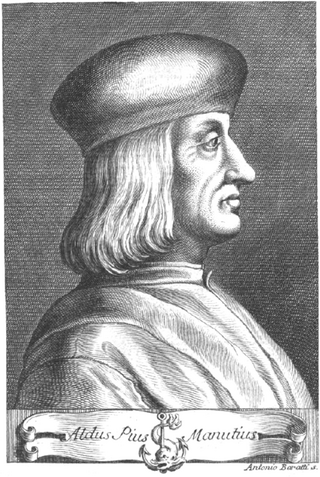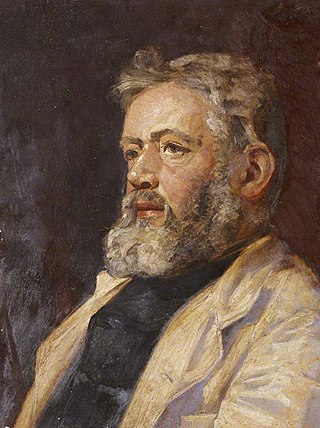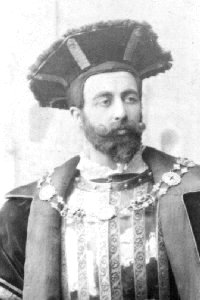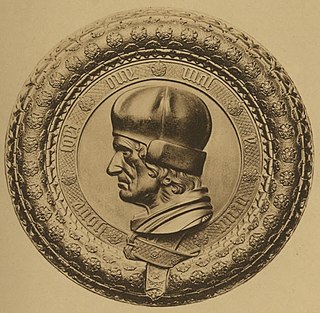Related Research Articles

James IV was King of Scotland from 11 June 1488 until his death at the Battle of Flodden in 1513. He inherited the throne at the age of fifteen on the death of his father, James III, at the Battle of Sauchieburn, following a rebellion in which the younger James was the figurehead of the rebels. James IV is generally regarded as the most successful of the Stewart monarchs. He was responsible for a major expansion of the Scottish royal navy, which included the founding of two royal dockyards and the acquisition or construction of 38 ships, including the Michael, the largest warship of its time.

Aldus Pius Manutius was an Italian printer and humanist who founded the Aldine Press. Manutius devoted the later part of his life to publishing and disseminating rare texts. His interest in and preservation of Greek manuscripts mark him as an innovative publisher of his age dedicated to the editions he produced. Aldus Manutius introduced the small portable book format with his enchiridia, which revolutionized personal reading and are the predecessor of the modern paperback book. He also helped to standardize use of punctuation including the comma and the semicolon.

John was a Scandinavian monarch under the Kalmar Union. He was king of Denmark (1481–1513), Norway (1483–1513) and as John II Sweden (1497–1501). From 1482 to 1513, he was concurrently duke of Schleswig and Holstein in joint rule with his brother Frederick.

Thomas Howard, 2nd Duke of Norfolk, styled Earl of Surrey from 1483 to 1485 and again from 1489 to 1514, was an English nobleman, soldier and statesman who served four monarchs. He was the eldest son of John Howard, 1st Duke of Norfolk, by his first wife, Catharina de Moleyns. The Duke was the grandfather of both Queen Anne Boleyn and Queen Katherine Howard and the great-grandfather of Queen Elizabeth I. In 1513, he led the English to victory over the Scots at the decisive Battle of Flodden, for which he was richly rewarded by King Henry VIII, then away in France.

Vice Admiral Cuthbert Collingwood, 1st Baron Collingwood was an admiral of the Royal Navy, notable as a partner with Lord Nelson in several of the British victories of the Napoleonic Wars, and frequently as Nelson's successor in commands.

Thomas Manners, 1st Earl of Rutland, 12th Baron de Ros of Helmsley, KG, of Belvoir Castle in Leicestershire, was created Earl of Rutland by King Henry VIII in 1525.

Nathan Charles Buckley is a former professional Australian rules football coach, player and commentator.

Matthew was a caravel sailed by John Cabot in 1497 from Bristol to Newfoundland, North America. There are two modern replicas – one in Bristol, England and one in Bonavista, Newfoundland.
The Lord Chancellor of Scotland, formally the Lord High Chancellor, was a Great Officer of State in the Kingdom of Scotland.

William Gershom Collingwood was an English author, artist, antiquary and professor of Fine Arts at University College, Reading. A long-term resident of Coniston, Cumbria, he was President of the Cumberland and Westmorland Antiquarian Society (1920-32) and the Lake Artists' Society.

Sir Edward Howard, KG was an English naval officer. He was the first of the Howards to win fame as an admiral, participating in his first naval battle while in his teens. He was in command during the Battle of Saint-Mathieu, which may have been the first sea battle fought by ships with cannons deployed through ports. He was killed shortly afterwards, leading an assault on galleys in the French fleet near Brest.

Sir Richard Cholmondeley was an English farmer and soldier, who served as Lieutenant of the Tower of London from 1513 to 1520 during the reign of Henry VIII. He is remembered because of his tomb at the Tower of London and because he is fictionalized as a character in Gilbert and Sullivan's darkly comic opera, The Yeomen of the Guard. Cholmeley's name has frequently been misspelled "Cholmondeley" because of its misspelling in the plaque on his tomb, which led to the misspelling of the character's name in the opera; other branches of Cholmeley's family use the longer spelling.

Theophilus Carter was an eccentric British furniture dealer who may have been an inspiration for the illustration by Sir John Tenniel of Lewis Carroll's characters the Mad Hatter in his 1865 novel Alice's Adventures in Wonderland and Hatta in the 1871 sequel Through the Looking-Glass.

Humphrey Arundell of Helland in Cornwall, was the leader of Cornish forces in the Prayer Book Rebellion early in the reign of King Edward VI. He was executed at Tyburn, London after the rebellion had been defeated.

Sir Thomas Lovell, KG was an English soldier and administrator, Speaker of the House of Commons, Secretary to the Treasury and Chancellor of the Exchequer.

Sir Robert Sheffield was an English lawyer and Member of Parliament. He was Speaker of the House of Commons between 1512–1513.
Edmund Curtis (1881–1943), was born in Lancashire to Irish parents. He worked in a rubber factory until he was 15 when he continued with his education. His education was paid for through donations when it was heard that poems he had published when he was 14 and later in London in June 1896 were from a factory worker.

Kara Del or Qara Del was a Mongol-led kingdom that existed in Qamil or Hami, in present-day Xinjiang. It was founded by the Yuan prince Gunashiri, a descendant of Chagatai Khan, in the late 14th century, and ruled by the Chagatayids thereafter until 1463. From 1380, it began to pay tribute to the Ming dynasty. From 1406, it was governed by Ming under the "Hami Guard" ; however, sometimes it was still under the influence of the Northern Yuan, and the ruler was called the Obedient King under the Jimi system. It was destroyed in 1513 as a result of the wars between the Ming dynasty and the Oirats, as well as dynastic succession struggles. Kara Del means "black chest" in the Old Mongol language.
Raffaello Petrucci was a Cardinal and Roman Catholic bishop.
References
![]() This article incorporates text from a publication now in the public domain : Clerke, Agnes Mary (1887). "Collingwood, Roger". In Stephen, Leslie (ed.). Dictionary of National Biography . Vol. 11. London: Smith, Elder & Co.
This article incorporates text from a publication now in the public domain : Clerke, Agnes Mary (1887). "Collingwood, Roger". In Stephen, Leslie (ed.). Dictionary of National Biography . Vol. 11. London: Smith, Elder & Co.